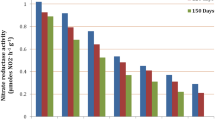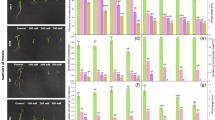Abstract
Sugarcane belonging to the genus Saccharum grown both in tropical and subtropical region is an important commercial crop. Modern sugarcane genotypes are derived largely from intercrossing of first mobilized hybrids and their progenies. A pot culture experiment was conducted to assess the effect of salt stress on sugarcane genotypes. Ten sugarcane genotypes viz, Co-94012, CoC-671, Co-740, CoM-0265, Co-86032, Co-9012, CoC-08026, CoM-08086, CoM-08011 and MS-08002, cultivated in three varying soil conditions viz., normal, saline and sodic soils were evaluated for the effect of salt stress on parameters such as proline, glycine betaine, soluble protein contents, nitrate reductase activity and pyrroline-5-carboxylate synthase activity. The analysis showed that the increased accumulation of proline, glycine betaine, soluble protein and increased activity of pyrroline-5-carboxylate synthase activity in sodic soil can be used as biochemical markers to screen the promising genotypes for salt tolerance in sugarcane.
Similar content being viewed by others
References
Alina, B.A., and L.K. Klyshev. 1975. Activity of nitrate reductase in the above ground parts of corn under conditions of salinization of the medium. Izvestiya Akademii Nauk Kazakhskoj SSR 1: 28–31.
Bates, L.S., R.P. Waldren, and I.D. Teare. 1973. Rapid determination of free proline for water stress studies. Plant and Soil 39: 205–207.
Boggess, S.F., and C.R. Stewart. 1976. Effect of water stress on proline synthesis from radioactive precursors. Plant Physiology 58: 398–401.
Chu, T.M., D. Aspinall, and L.G. Paleg. 1976. Stress metabolism. VIII. Specific ion effects on proline accumulation in barley. Australian Journal of Plant Physiology 3: 503–511.
Du, Y.C., Y. Kawamitsu, A. Nose, S. Higane, K. Wasano, S. Hiyane, S. Murayame, and Y. Uchida. 1996. Effect of water stress on carbon exchange rate and activities of photosynthetic enzymes in leaves of sugarcane (Saccharum sp.). Australian Journal of Plant Physiology 23: 719–726.
Hayzer, D.J., and T. Leisinger. 1980. The gene–enzyme relationships of proline biosynthesis in Escherichia coli. Journal of General Microbiology 118: 287–293.
Jiang, Y.W., and B.R. Huang. 2002. Protein alterations in tall fescue in response to drought stress and abscisic acid. Crop Science 42: 202–207.
Krishnamurthy, R.M., and K.A. Anabazhganand Bhaswaty. 1987. Accumulation of free amino acids and distribution of Na+, Cl− and K+ in rice varieties exposed to NaCl stress. Indian Journal of Plant Physiology 30(2): 183–188.
Lowry, O.H., N.J. Rosebrough, A.L. Farr, and R.J. Randall. 1951. Protein measurement with the Folin’s phenol reagent. Journal of Biological Chemistry 193: 265–275.
Lu, Z.X., B. Xu, C.G.I. BI. 1986. The accumulation of free proline is wheat seedlings in NaCl, MgCl2 sol. Journal of Nanjing University Natural Sciences 22(1): 100–105.
Menossi, M., M.C. Silva-Filho, M. Vincentz, M.A. Van-Sluys, and G.M. Souza. 2008. Sugarcane functional genomics: Gene discovery for agronomic trait development. International Journal of Plant Genomics 2008: 458732. doi:10.1155/2008.
Papini-Terzi, F.S., F.R. Rocha, R.Z.N. Vencio, J.M. Felix, D.S. Branco, A.J. Waclawovsky, L.E.V. DelBem, C.G. Lembke, M.D.L. Costa, M.Y. Nashiyama Jr, R. Vicentini, M.G.A. Vincentz, E.C. Ulian, M. Menossi, and G.M. Souza. 2009. Sugarcane genes associated with sucrose content. BMC Genomics 10: 1–34.
Saif-Ur-Rasheed, M., S. Asad, Y. Zafar, and R.A. Waheed. 2001. Use of radiation and in vitro techniques for development of salt tolerant mutants in sugarcane and potato. IAEA-TECDOC 1227: 61–74.
Sakamoto, A., and N. Murata. 2002. The role of glycine betaine in the protection of plants from stress: Clues from transgenic plants. Plant, Cell and Environment 25: 163–171.
Sawhney, S.K., M.S. Naik, and D.J.D. Nicholas. 1978. Regulation of nitrate reduction by light, ATP and mitochondrial respiration in wheat leaves. Nature 272: 647–648.
Sharma, K.D., K. Datta, and S.K. Varma. 1990. Effect of chloride and sulphate types of salinity on some metabolic drifts in chickpea (Cicer arietinum L.). Indian Journal of Experimental Biology 28: 890–892.
Stewart, G.R., and J.A. Lee. 1974. The role of proline accumulation in halophytes. Planta 120: 279–289.
Stumpf, D.K. 1984. Quantitation and purification of quaternary ammonium compounds from halophyte tissue. Plant Physiology 75: 273–274.
Author information
Authors and Affiliations
Corresponding author
Rights and permissions
About this article
Cite this article
Mahajan, S.T., Naik, R.M. & Dalvi, U.S. Assessment of Biochemical Markers in Differentiating Sugarcane Genotypes for Salt Tolerance. Sugar Tech 15, 116–121 (2013). https://doi.org/10.1007/s12355-013-0207-z
Received:
Accepted:
Published:
Issue Date:
DOI: https://doi.org/10.1007/s12355-013-0207-z




